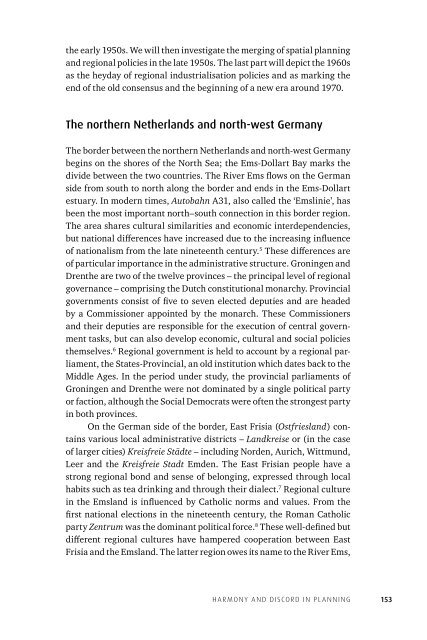Discord Consensus
7aze300jFJo
7aze300jFJo
Create successful ePaper yourself
Turn your PDF publications into a flip-book with our unique Google optimized e-Paper software.
the early 1950s. We will then investigate the merging of spatial planning<br />
and regional policies in the late 1950s. The last part will depict the 1960s<br />
as the heyday of regional industrialisation policies and as marking the<br />
end of the old consensus and the beginning of a new era around 1970.<br />
The northern Netherlands and north-west Germany<br />
The border between the northern Netherlands and north-west Germany<br />
begins on the shores of the North Sea; the Ems-Dollart Bay marks the<br />
divide between the two countries. The River Ems flows on the German<br />
side from south to north along the border and ends in the Ems-Dollart<br />
estuary. In modern times, Autobahn A31, also called the ‘Emslinie’, has<br />
been the most important north–south connection in this border region.<br />
The area shares cultural similarities and economic interdependencies,<br />
but national differences have increased due to the increasing influence<br />
of nationalism from the late nineteenth century. 5 These differences are<br />
of particular importance in the administrative structure. Groningen and<br />
Drenthe are two of the twelve provinces –the principal level of regional<br />
governance – comprising the Dutch constitutional monarchy. Provincial<br />
governments consist of five to seven elected deputies and are headed<br />
by a Commissioner appointed by the monarch. These Commissioners<br />
and their deputies are responsible for the execution of central government<br />
tasks, but can also develop economic, cultural and social policies<br />
themselves. 6 Regional government is held to account by a regional parliament,<br />
the States-Provincial, an old institution which dates back to the<br />
Middle Ages. In the period under study, the provincial parliaments of<br />
Groningen and Drenthe were not dominated by a single political party<br />
or faction, although the Social Democrats were often the strongest party<br />
in both provinces.<br />
On the German side of the border, East Frisia (Ostfriesland) contains<br />
various local administrative districts –Landkreise or (in the case<br />
of larger cities) Kreisfreie Städte –including Norden, Aurich, Wittmund,<br />
Leer and the Kreisfreie Stadt Emden. The East Frisian people have a<br />
strong regional bond and sense of belonging, expressed through local<br />
habits such as tea drinking and through their dialect. 7 Regional culture<br />
in the Emsland is influenced by Catholic norms and values. From the<br />
first national elections in the nineteenth century, the Roman Catholic<br />
party Zentrum was the dominant political force. 8 These well-defined but<br />
different regional cultures have hampered cooperation between East<br />
Frisia and the Emsland. The latter region owes its name to the River Ems,<br />
Harmony and discord in planning 153


